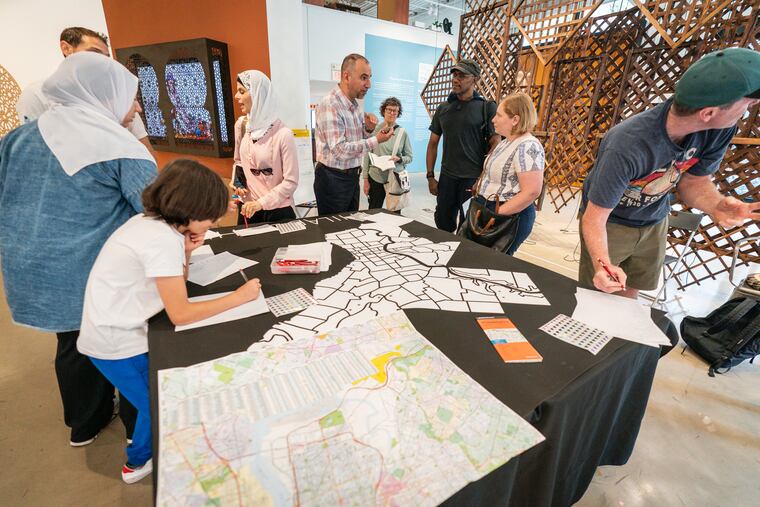A welcoming map: Community organizers launch first Philly map in Arabic
The project, spearheaded by Friends, Peace, Sanctuary Journal, will draw connections between Arab and non-Arab communities, places, and stories.

“Are you ready to interact?” Nora Elmarzouky asked a group of about 20 people at the Museum for Art in Wood on Friday afternoon. Between them, a giant, blank map of Philadelphia and its neighborhood borders was spread out on a table.
“Find someone here that you don’t know, and talk to them about why you’re in the city of Philadelphia,” she prompted the crowd.
She looked to her business partner Yaroub Al-Obaidi, who then translated the prompt to Arabic. The room was quickly filled with the voices of people chattering excitedly with each other, their voices bouncing off the walls.
Elmarzouky and Al-Obaidi, who are co-founders of the Philadelphia-based Arabic newspaper Friends, Peace, Sanctuary Journal, were hosting their first workshop for a new project they’re embarking on: a map of Philadelphia in Arabic.
“Mapping is a way to make understanding of the context by which we live.”
The map will have street names and notable locations across the city translated to Arabic. But it will also tell stories: stories of Philadelphia’s Arab communities and culture — and non-Arabs interactions with that — stories of back home, and how every place, and every person, is somehow connected. Once completed, the organizers believe, the map would be the first of its kind in Philadelphia, and would appear to be the first Arabic map of any U.S. city.
“We want to document the Arab journey in Philadelphia, and also Americans who engage with our community,” said Al-Obaidi. “In the future, it will be something amazing to be proud of.”
Navigating and understanding the city
The idea for the map started rather simply, as a way to make newcomers feel more welcomed in Philadelphia and aid them in navigating and understanding their new city. But Al-Obaidi and Elmarzouky had a guiding question that made the project evolve: How do we make meaning out of this?
“Mapping is a way to make understanding of the context by which we live,” Elmarzouky explained. “We experience life in this space, in this city, and this is a way to process that — to think about, ‘What is my connection to this place, even if I’m not ‘from here’?”
» READ MORE: Arabs have a longstanding history in Philadelphia — and this bilingual newspaper honors it
As the workshop continued, Al-Obaidi overheard one attendee, a Syrian refugee, share that while he was on his way to the refugee resettlement agency HIAS PA to complete paperwork, one street he walked transported him back to Damascus; something about the Philadelphia street’s scenery reminded him of home.
It’s stories like these that Al-Obaidi and Elmarzouky are trying to prompt from workshop attendees: What reminds you of home? What’s a place in Philadelphia that means a lot to you, and why? They’re ways to hold on to home, while establishing a sense of belonging in their new homes.
The workshop achieved that objective for Yaqeen Yamani, an MFA student at Temple University who is from Jericho, a Palestinian city in the West Bank.
“It feels more welcoming, and for me, it felt more like I belong to these kinds of people who try to do something like an Arabic journal or mapping Philadelphia in Arabic,” said Yamani. “Doing such an activity to connect people together is really interesting to me, especially in a new place that I’m trying to discover.”
Connecting with other communities of color
The map will also honor the stories and existence of other communities of color in Philadelphia: One layer will include the names and spaces of the Lenni Lenape, “who are the Native Americans whose land we are currently occupying,” Elmarzouky told attendees Friday. Another layer will represent the history of the Underground Railroad.
“In the future, it will be something amazing to be proud of.”
“We really want to connect those layers together, and our immigrant population, with our histories that are so critical and important to Philadelphia,” Elmarzouky said.
Al-Obaidi and Elmarzouky are planning to host workshops every other month over the next year to engage community members to tell their stories of Philadelphia, and invite all Philadelphians to attend, as well as institutions to sponsor their locations on the map. Follow them on social media @fpsjournal for updates or email them at parabicnews@gmail.com.